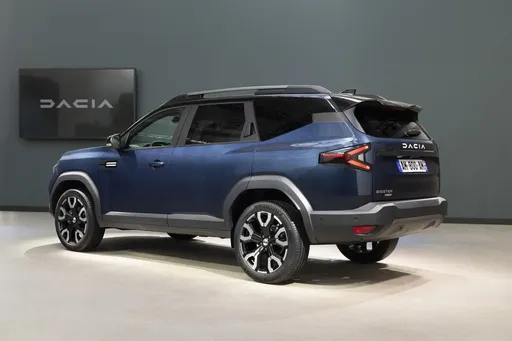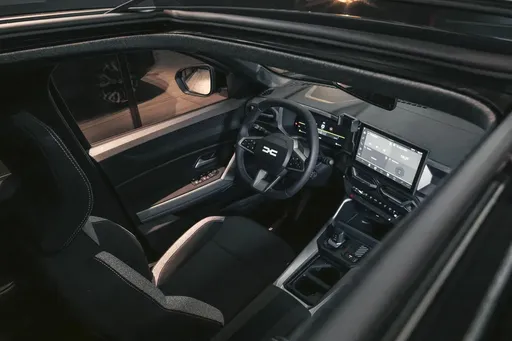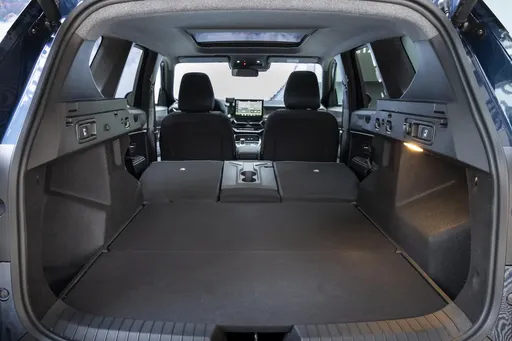SsangYong Torres vs Dacia Bigster – Kumpi malli toimii paremmin arjessa?
Olipa kyse arjesta, perheestä tai pitkistä matkoista – tässä näkyvät erot.
Selvitä, sopiiko SsangYong Torres vai Dacia Bigster paremmin elämäntyyliisi.
The Battle of Practicality: SsangYong Torres vs. Dacia Bigster
In the ever-evolving world of SUVs, the choice often narrows down to practicality, performance, and innovation. Here, we pit the SsangYong Torres against the Dacia Bigster, both vying for attention in the bustling SUV market. These contenders bring unique specifications and strengths to the table, making for an intriguing comparison. Let's dive into the essence of these formidable SUVs.
Design and Dimensions: Cutting Through the Air
The SsangYong Torres steps into the arena with its commanding dimensions. At 4700mm in length, 1890mm in width, and 1710mm in height, it possesses an authoritative road presence. On the other hand, the Dacia Bigster, slightly more compact, measures 4570mm in length, 1813mm in width, and 1705mm in height. Both SUVs maintain a five-door configuration, offering ease of access and practicality.
Performance and Power: The Heart of the Machine
The SsangYong Torres delivers with a range of power options, catering to diverse preferences. The petrol and electric variants offer power outputs of 163 HP and 207 HP, respectively. Performance is matched with an impressive torque range between 280 Nm and 339 Nm, ensuring responsive driving dynamics. Meanwhile, the Dacia Bigster, equipped with its selection of petrol MHEV, full hybrid, and LPG engines, generates power between 130 HP and 155 HP and torque reaching up to 230 Nm.
Efficiency and Range: Traveling the Distance
Fuel efficiency marks a decisive battle front. The SsangYong Torres displays a consumption range from 7.9 L/100km to 9.1 L/100km, while offering an electric range of up to 462 km at 18.7 kWh/100km. The Dacia Bigster stands out with its efficient figures—consumption between 4.7 L/100km and 6.1 L/100km—providing a cost-effective ride. Additionally, the hybrid nature of the Bigster's engine lineup promises reduced emissions and enhanced fuel efficiency.
Interior and Cargo: Space and Comfort
Inside, both SUVs are tailored for comfort and utility. The SsangYong Torres offers a spacious trunk capacity of 703 liters, complemented by a payload capacity of 552 kg, making it an excellent choice for families and adventurers alike. Conversely, the Dacia Bigster, with trunk capacities ranging from 546 liters to 667 liters, provides ample space for urban and off-road use, albeit with a slightly lower payload capacity.
Technical Innovations: A Leap into the Future
Tech-savvy drivers will appreciate the advanced features present in both models. The Torres showcases its transmission versatility with manual and automatic options, including a reduction gearbox for its all-wheel-drive variant. Dacia Bigster, though primarily available with a manual gearbox, promises simplicity and reliability that are quintessential for daily commuters.
Conclusion: Which Is Your Perfect Companion?
The decision between the SsangYong Torres and the Dacia Bigster ultimately rests on the priorities of the potential buyer. The Torres leans towards power, space, and technological integration, while the Bigster emphasizes efficiency, practicality, and affordability. Whether your choice leans towards power with the Torres or economical versatility with the Bigster, both SUVs emerge as strong contenders in their respective realms, perfectly poised to meet diverse customer needs.
In this showdown of SUVs, both the SsangYong Torres and Dacia Bigster deliver remarkable offerings. It remains for the discerning driver to decide which path to embark upon—power versus economy. Which journey will you choose?
Tässä mennään yksityiskohtiin: tekniset erot tarkemmin
Kustannukset ja kulutus: Hinnan ja tehokkuuden vertailussa erot tulevat usein selvimmin esiin. Tässä ratkaistaan, kumpi malli sopii paremmin budjettiisi pitkällä aikavälillä.
Dacia Bigster on hinnassa merkittävä edullisempi – sen lähtöhinta on 24000 €, kun taas SsangYong Torres maksaa 39500 €. Ero on noin 15500 €.
Polttoaineenkulutuksessa näkyy ero: Dacia Bigster kuluttaa 4.70 L ja on siten vakuuttava taloudellisempi kuin SsangYong Torres, jonka kulutus on 7.90 L. Ero on noin 3.20 L /100 km.
Moottori ja suorituskyky: Teho, vääntömomentti ja kiihtyvyys ovat autoharrastajien klassisia mittareita – ja erot tulevat tässä hyvin esiin.
Moottoritehossa SsangYong Torres on ilmeinen etulyöntiasemassa – 207 hv verrattuna 155 hv:een. Ero on noin 52 hv hv.
Huippunopeudessa SsangYong Torres on vähäinen edellä – se yltää 194 km/h:een, kun taas Dacia Bigster saavuttaa 180 km/h. Ero on noin 14 km/h.
Vääntömomentissa näkyy myös ero: SsangYong Torres vetää selvästi havaittava voimakkaammin, 339 Nm verrattuna 230 Nm:een. Eroa on noin 109 Nm.
Tila ja käytännöllisyys: Sisätilat, tavaratila ja kantavuus ratkaisevat auton arjen käytettävyyden. Mukavuus ja joustavuus ovat avainasemassa.
Molemmissa autoissa on tilaa 5 henkilölle.
Omapainossa Dacia Bigster on vähäinen kevyempi – 1425 kg verrattuna 1498 kg:een. Painoero on noin 73 kg.
Tavaratilan koossa SsangYong Torres tarjoaa kevyt enemmän – 703 L verrattuna 667 L:een. Ero on noin 36 L.
Maksimikantavuudessa Dacia Bigster pärjää pienessä määrin paremmin – jopa 1937 L, noin 275 L enemmän kuin SsangYong Torres.
Kantavuudessa SsangYong Torres on jonkin verran parempi – 552 kg verrattuna 467 kg:een. Ero on noin 85 kg.
Yhteenvetomme: Dacia Bigster osoittautuu olevan voittaa vertailun selvästi ja saa siksi tittelin DriveDuel Champion!
Tässä vertailussa Dacia Bigster on monipuolisempi kokonaisuus.
SsangYong Torres
Torres on uudistava malli, joka yhdistää tyylikkään muotoilun ja käytännöllisyyden. Sen tilava sisustus tarjoaa erinomaisen mukavuuden niin kaupunki- kuin maastoajoon. Tämä auto on suunniteltu erityisesti nuorekkaille ja aktiivisille perheille, jotka arvostavat monikäyttöisyyttä ja modernia muotoilua.
TiedotDacia Bigster
The Bigster is poised to redefine the SUV segment with its bold design and spacious interior, catering to the needs of both families and adventure seekers alike. Emphasizing sustainability and practicality, this model reflects a modern approach to automotive engineering, making it a compelling choice for environmentally conscious drivers. With its striking presence on the road, the Bigster not only captures attention but also embodies a new era of versatile mobility.
Tiedot @ media.renault.at
@ media.renault.at
 @ media.renault.at
@ media.renault.at
 @ media.renault.at
@ media.renault.at
 @ media.renault.at
@ media.renault.at
 @ media.renault.at
@ media.renault.at

|
|
|
|
|
Kustannukset ja kulutus |
|
|---|---|
|
Hinta
39500 - 52000 €
|
Hinta
24000 - 31000 €
|
|
Kulutus L/100km
7.9 - 9.1 L
|
Kulutus L/100km
4.7 - 7.1 L
|
|
Kulutus kWh/100km
18.70 kWh
|
Kulutus kWh/100km
-
|
|
Sähköinen toimintasäde
462 km
|
Sähköinen toimintasäde
-
|
|
Akun kapasiteetti
-
|
Akun kapasiteetti
-
|
|
CO2
0 - 207 g/km
|
CO2
106 - 137 g/km
|
|
Polttoainesäiliön tilavuus
50 L
|
Polttoainesäiliön tilavuus
50 - 55 L
|
Mitat ja kori |
|
|---|---|
|
Kori
SUV
|
Kori
SUV
|
|
Istuimet
5
|
Istuimet
5
|
|
Ovet
5
|
Ovet
5
|
|
Omamassa
1498 - 1618 kg
|
Omamassa
1425 - 1547 kg
|
|
Tavaratila
703 L
|
Tavaratila
510 - 667 L
|
|
Pituus
4700 mm
|
Pituus
4570 mm
|
|
Leveys
1890 mm
|
Leveys
1813 mm
|
|
Korkeus
1710 mm
|
Korkeus
1705 mm
|
|
Maksimi tavaratila
1662 L
|
Maksimi tavaratila
1813 - 1937 L
|
|
Kantavuus
552 kg
|
Kantavuus
383 - 467 kg
|
Moottori ja suorituskyky |
|
|---|---|
|
Moottorityyppi
Bensiini, Sähkö
|
Moottorityyppi
Bensiini MHEV, Täyshybridi, Kaasu (LPG)
|
|
Vaihteisto
Manuel, Automaatti
|
Vaihteisto
Manuel, Automaatti
|
|
Vaihteiston tyyppi
Manuaalivaihteisto, Automaattivaihteisto, Alennusvaihteisto
|
Vaihteiston tyyppi
Manuaalivaihteisto, Automaattinen manuaalivaihteisto
|
|
Vetotapa
Etuveto, Neliveto
|
Vetotapa
Neliveto, Etuveto
|
|
Teho hv
163 - 207 hv
|
Teho hv
130 - 155 hv
|
|
Kiihtyvyys 0-100 km/h
-
|
Kiihtyvyys 0-100 km/h
9.7 - 11.2 s
|
|
Huippunopeus
191 - 194 km/h
|
Huippunopeus
180 km/h
|
|
Vääntömomentti
280 - 339 Nm
|
Vääntömomentti
230 Nm
|
|
Sylinterien lukumäärä
4
|
Sylinterien lukumäärä
3 - 4
|
|
Teho kW
120 - 152 kW
|
Teho kW
96 - 115 kW
|
|
Iskutilavuus
1497 cm3
|
Iskutilavuus
1199 - 1799 cm3
|
Yleiset |
|
|---|---|
|
Mallivuosi
2023 - 2024
|
Mallivuosi
2025
|
|
CO2-tehokkuusluokka
G, A
|
CO2-tehokkuusluokka
E, D, C
|
|
Merkki
SsangYong
|
Merkki
Dacia
|
Onko SsangYong Torres saatavana eri vetotavoilla?
Saatavilla olevat vaihtoehdot: Etuveto tai Neliveto.
Näytetyt hinnat ja tiedot ovat arvioita, jotka perustuvat Saksan listahintoihin, ja voivat vaihdella maittain. Nämä tiedot eivät ole oikeudellisesti sitovia.
